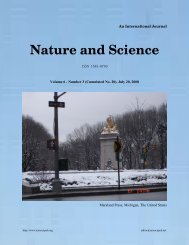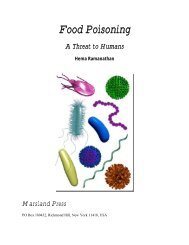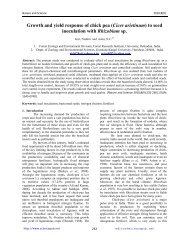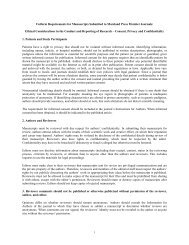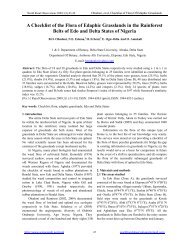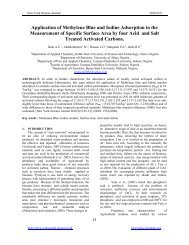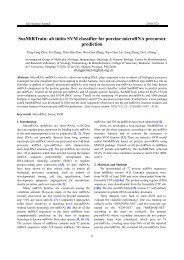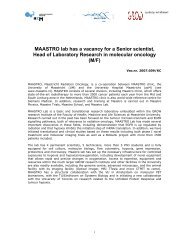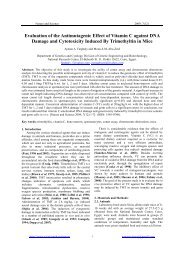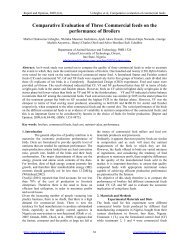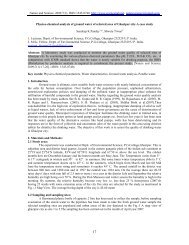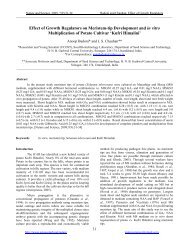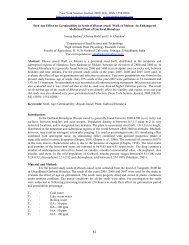Phytochemical screening of the leaves of Lophira lanceolata ...
Phytochemical screening of the leaves of Lophira lanceolata ...
Phytochemical screening of the leaves of Lophira lanceolata ...
Create successful ePaper yourself
Turn your PDF publications into a flip-book with our unique Google optimized e-Paper software.
Life Science Journal, Vol 4, No 4, 2007<br />
http://lsj.zzu.edu.cn<br />
hot water. The water insoluble portion was dissolved in<br />
ethanol and dried under reduced pressure. A solid brown<br />
residue (30.2 g) obtained respond to usual flavonoid colour<br />
tests was marked “A”.<br />
The aqueous solution was extracted with ethyl acetate.<br />
The process was repeated twice. The ethyl acetate extract<br />
where combined and <strong>the</strong> solvent was recovered under reduced<br />
pressure. The semi- solid residue was marked “A 1 ”<br />
and respond to usual flavonoidal test.<br />
2.2 Thin layer chromatographic examination <strong>of</strong> fraction<br />
“A”<br />
Thin layer chromatographic plate (5 × 20 cm) 0.5 mm<br />
thickness was prepared by usual method using silica gel<br />
G (E.Merck). The sample <strong>of</strong> 0.1% <strong>of</strong> “A” was dissolve in<br />
alcohol and spotted manually using a capillary tube. The<br />
plate was developed in BPF (benzene : pyridine : formic<br />
acid, 36 : 9 : 5) as solvent system. After development, on<br />
examination <strong>of</strong> <strong>the</strong> chromatogram under U.V. light and<br />
<strong>the</strong>n sprayed with ferric chloride <strong>the</strong> presence <strong>of</strong> one spot<br />
with trailing was revealed. This was purified with column<br />
chromatography.<br />
2.3 Fraction “A 1 ”<br />
The ethanol solution <strong>of</strong> fraction “A 1 ” was subjected to<br />
paper chromatographic analysis using Whatmann paper<br />
No.1. In each solvent system, <strong>the</strong> chromatograms were<br />
developed for 10 hours. After drying in fume cupboard,<br />
<strong>the</strong> chromatograms were examined under U.V. light,<br />
which revealed <strong>the</strong> presence <strong>of</strong> two spots with trailing.<br />
2.4 Hydrolysis <strong>of</strong> fraction “A 1 ”<br />
10 mg <strong>of</strong> fraction “A 1 ” was dissolved in water and hydrolyzed<br />
by refluxing with 2 ml <strong>of</strong> 0.6 M hydrochloric<br />
acid. The hydrolysis appeared to be completed within a<br />
few munites, but <strong>the</strong> heating was continued for 2 hours to<br />
ensure complete hydrolysis. After leaving over-night, <strong>the</strong><br />
aglycone was filtered, washed, dried at room temperature<br />
and marked fraction G.<br />
2.5 Chromatographic identification <strong>of</strong> <strong>the</strong> sugar<br />
The filtrate (from which <strong>the</strong> aglycone was removed)<br />
was neutralized with aqueous ammonia until it was neutral<br />
to litmus paper. It was concentrated under reduced<br />
pressure to a syrupy mass. This syrupy mass was chromatographed<br />
on whatmann paper No. 1 using n-Butanol<br />
: acetic acid : water (4 : 1 : 5) as solvent system with<br />
au<strong>the</strong>ntic (reference sugar) samples. The chromatogram<br />
after development was dried in a fume cupboard sprayed<br />
with aniline-H-phthalate reagent and <strong>the</strong>n heated at 110ºC<br />
for 5 minutes. After development on examination <strong>the</strong><br />
chromatogram shows <strong>the</strong> presence <strong>of</strong> a spots equivalent<br />
to R f values <strong>of</strong> au<strong>the</strong>ntic glucose were revealed.<br />
2.6 Preparation <strong>of</strong> au<strong>the</strong>ntic sugar<br />
The au<strong>the</strong>ntic sugar rhamnose, glucose, galactose,<br />
fructose, xylose and arabinose were prepared by dissolving<br />
small sample <strong>of</strong> <strong>the</strong> sugar in distilled water.<br />
2.7 Quantitative evaluation <strong>of</strong> <strong>the</strong> leave <strong>of</strong> <strong>Lophira</strong> <strong>lanceolata</strong><br />
<strong>leaves</strong>.<br />
(a) Determination <strong>of</strong> total ash value<br />
(b) Determination <strong>of</strong> acid insoluble ash value<br />
(c) Determination <strong>of</strong> water-soluble ash value<br />
(d) Alcohol soluble extractive value<br />
(e) Water soluble extractive value (British Pharmacopoeia,<br />
1993).<br />
3 Results<br />
On defatting <strong>the</strong> powdered leave <strong>of</strong> <strong>the</strong> plant material<br />
with petroleum e<strong>the</strong>r (60 – 80 ºC), <strong>the</strong> merc was extracted<br />
with ethanol. The ethanol extract was fractionated into<br />
fraction “A” and fraction “A 1 ” both <strong>of</strong> which gave usual<br />
colour test for flavonoid.<br />
3.1 <strong>Phytochemical</strong> <strong>screening</strong><br />
The result <strong>of</strong> <strong>the</strong> phytochemical <strong>screening</strong> <strong>of</strong> ethanol<br />
(fraction “A”) (A), chlor<strong>of</strong>orm (B) and petroleum e<strong>the</strong>r<br />
(C) extracts was summarized in Table 1.<br />
3.2 Determination <strong>of</strong> ash value <strong>of</strong> lophira <strong>lanceolata</strong><br />
<strong>leaves</strong><br />
Evaluation <strong>of</strong> crude powder leave <strong>of</strong> <strong>the</strong> plant <strong>Lophira</strong><br />
<strong>lanceolata</strong> in Table 2.<br />
3.3 Colour test <strong>of</strong> fraction “A”<br />
The result <strong>of</strong> various colour reactions conducted on<br />
fraction “A” was summarized in Table 3.<br />
3.4 Colour test <strong>of</strong> fraction “A 1 ”<br />
The result <strong>of</strong> various colour reactions conducted on<br />
fraction “A 1 ” was summarize in Table 4.<br />
3.5 Thin layer chromatographic examination <strong>of</strong> fraction<br />
“A” in three different solvent<br />
BPF, 36 : 9 : 5; TPA, 10 : 1 : 1 and B : EA : A, 8 : 5 : 2<br />
gave a good chromatogram, Figure 1.<br />
3.6 Result <strong>of</strong> hydrolyzed extract G<br />
The aqueous sugar portion after hydrolysis and neutralization<br />
was chromatographed with reference au<strong>the</strong>n-<br />
∙ 76 ∙



